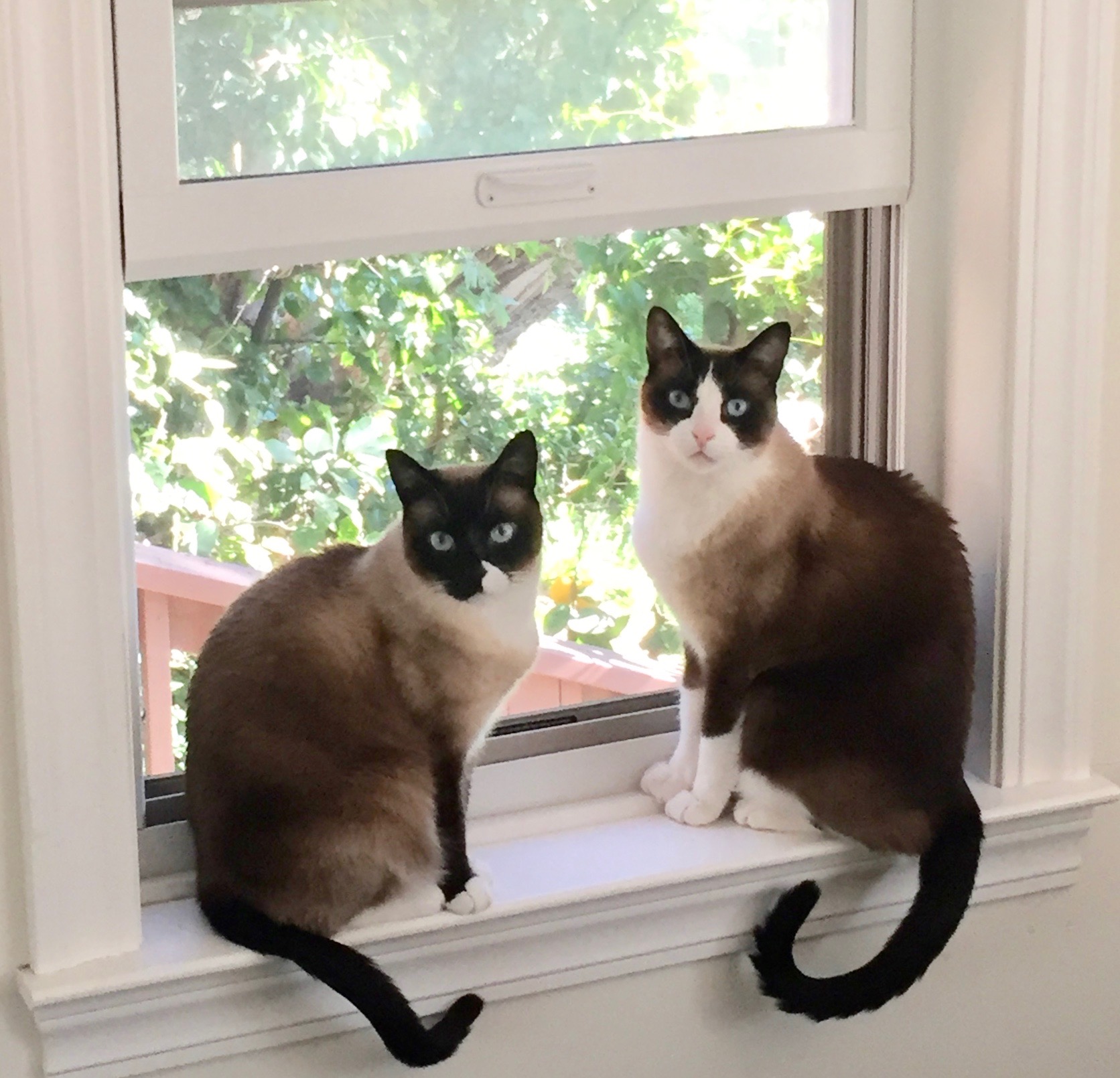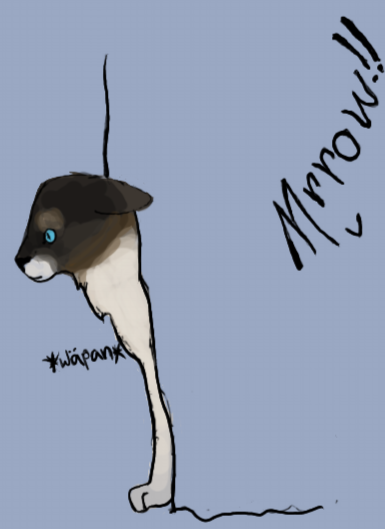Kaltxì, ma frapo!
It’s my pleasure to present to you a little story, written by our Tsm. Tsyili, about two cats—but not just any two cats: our two beloved kitties, Palu and Lukan! John and I have had them—or they’ve had us—for almost five years, since they were tiny. They’re Snowshoe Siamese, brother and sister from the same litter. Lukan, the male (on the right in the photo), is big, brave, and boisterous. His sister Palu is smaller and bit on the shy side, although she’s come a long way. We think they’re both gorgeous.
Tsyili’s charming story is short and simple, the kind that even beginners with only a few months of Na’vi should be able to grasp without too much difficulty.
Before you listen, you might want to refresh your memory on these words, listed in alphabetical order:
fewi
hangham
hasey
laro si
lätxayn
leym
pxi
pxìm
sto
swirä
tìng tseng
tsin
tstew
uvan si
velek
wan
wok
There’s also a new vocabulary item you need to know:
pxul (adj.) ‘formidable, imposing’
Derivations:
tìpxul (n., tì.PXUL) ‘formidableness, imposingness’ (two rare and awkward words in English!)
nìpxul (adv., nì.PXUL) ‘formidably, imposingly’
Unlike nawm ‘great, noble,’ pxul can refer to things either good or bad, as long they’re treated seriously and not taken lightly.
Fìsäwemìri zene awnga kawl häpivawl. Lu Sawtute wätu apxul.
‘We must prepare diligently for this fight. The Skypeople are formidable opponents.’
säwem (n., sä.WEM) ‘fight’
You’ll hear three voices in the recording, those of Tsyili, Tirea Aean, and Pawl.
And here’s a delightful illustration, also by Tsyili:
Mawkrra ngal vurit yolune, fìtìpawmìri rutxe ’iveyng: Tsaswirä apxul lu peu? 😊
Hayalovay!




Seysonìltsan ma Karyu Pawl sì Tirea Aean sì Tsyili!
Tsavur lu ‘ipu nì’it ulte fìmefalulukan lu hona nìtxan.
Oe ke tsun wivan tì’eyngit slä swirä apxul lu sä’o a laro si kllteru 😛
Kolan fìmefalu(lu)kantsyìp hrh
👍 😊
Nìpxi. Vur a lu lor sì ’ipu! Pxengaru irayo seiyi.
Mefalukantsyìp smeion oer nì’it ulte mefeyä säfpìl lam ngay nìpxi 🙂
Mefol oeta volin futa rutxe piveng Stefanur san nga lom lu moer.
Irayo pxengaru! Sunu oeru fìvur a sko comprehensible input. 😉
Kop, ngeyä tsamefalukantsyìpìri fkan narlor nìtxan nang! Sevin sayrìpsì.
Kezemplltxe, mllte oe ngahu nìwotx. 😊
Is there a difference in meaning between «lu Sawtute aywätu apxul» and «lu Sawtute wätu apxul»? Or in other words, why is the grammatical number marked twice in this clause?
Irayo, ma tsmuk. Sìltsana sätseri, sìltsana tìpawm.
sätseri (n., sä.TSE.ri) ‘observation, something noticed’
Here on the blog, my main discussion of number agreement was nine years ago (hard to believe how fast time goes by!), in a post on July 30, 2011. That was where I explained the KH—Koren Holpxayä: “In referring to the same entity, express number only once per clause.”
You’re quite right that my example with aywätu violated this principle. So for the time being I’ve edited it to remove ay-. Thanks for that!
However, on further thought, I’m wondering if there might not be a valid reason to consider both wätu and aywätu possible here—that is, if there might not be another valid exception to the KH.
The one exception we’ve seen so far, which I noted in 2011, invoved tupe. I pointed out that to ask “Who are those warriors?” there were two possibilities: (A) Tsaysamsiyu lu tupe? And (B) Tsaysamsiyu lu supe? (A) follows the KH; (B) violates it. The difference is that (A) asks for the defining characteristic of the group; the answer might be (Fo) lu oeyä ’eylan. (B), on the other hand, asks for the individual identities of the warriors; the answer might be (Fo) lu Kamun, Ralu, Ìstaw, sì Ateyo.
I’m wondering whether there might not be a similar distinction between wätu and aywätu in the example. The form that follows the KH—(C) Lu Sawtute wätu apxul—considers the group characteristic: the Skypeople, when they band together as a group, constitute a formidable opponent. The form that violates the KH—(D) Lu Sawtute aywätu apxul—focuses on individual Skypeople: each individual Skyperson is himself or herself a formidable opponent.
Fìtxeleri zene oe fpivìl nì’ul. Slä txo livu tuteor aysäfpìl a fìtìpawmteri, rutxe piveng oer!
Irayo ma Karyu!
What an interesting distinction concept, making both forms valid but with a subtle difference in meaning. 😀 I don’t have a particular preference on whether or not that should be a thing, but I sort of do have a bit of a habit of adhering to KH after all these years 😉
Have to agree with you there, ma Tirea. Although I see the advantage this variation of KH has.
Irayo nìtxan, tsavur lu txantsan. Tìtslam lu ngäzìk tenkrr tìng mikyun taluna aylì’u lu win. Slä oe fmi frakrr.
Rä’ä ftang fmivi, ma tsmuk! Siva ko . . . ulte nga flayä!